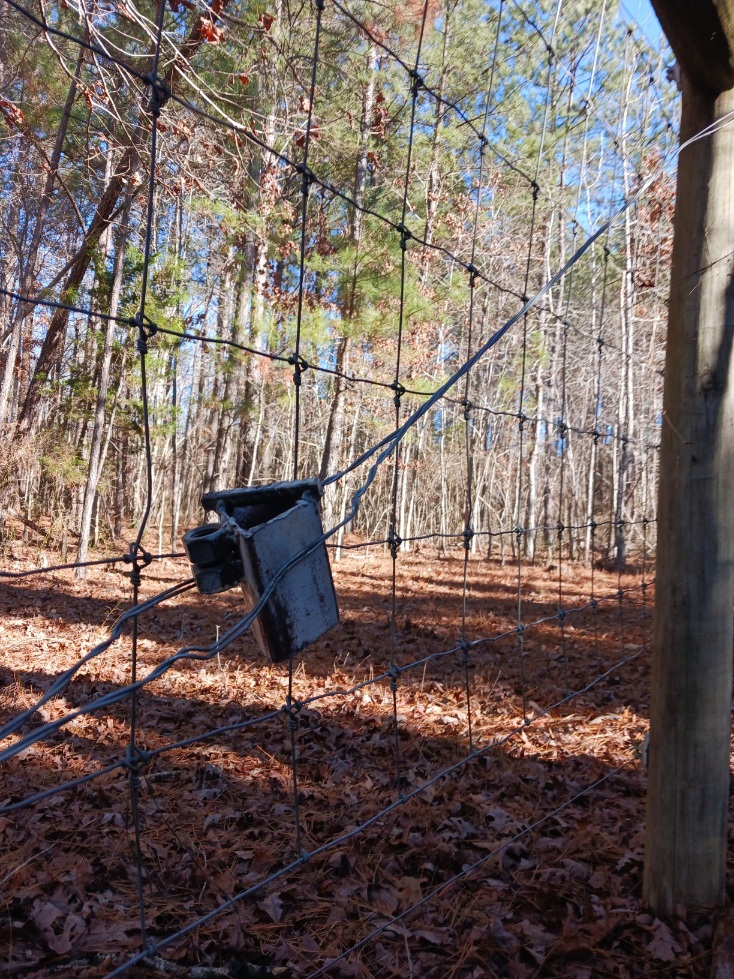When I was first installing the fence I built H braces that used the traditional method of tensioning the wire component of the H brace with a twist stick. The twist stick is simply a stick placed between wires wrapped horizonally around the brace and twisted round and round causing the wires to wrap around each other. This, in turn, makes the wires shorten lengthwise, which creates the desired tension in the H brace. This tensioned wire is critical to the strenth of the brace. When you've finished twisting the stick there is a lot of tension on it to the point the if you let it go the force of the wires untwisting would send the stick whipping around and probably give you a good wallop in either the face or the crotch depending on where you stood. To keep this from happening you place the end of the stick not engaged in the wires against the horizonal bar of the H brace and use a short length of wire to anchor it there. Then you're free to stretch your fencing wire.
I've done many many H braces over time and, unfortunately, on many of my early H braces, I didn't use the right kind of wood for the twist stick. Having come from a more northern climate, I didn't realize how easily and quickly most wood rots in the southern US. Consequently, over time, many of my twist sticks have rotted and started breaking.
In my more recent H braces I've used the miraculous wood from the juniper tree for my twist sticks. These will likely last as long or longer than the pressure treated wood I used for my fence posts. Juniper wood and especially juniper heartwood will last many decades and I can often find heartwood laying on the ground from juniper trees that died long ago. In fact on the edge of my property I've found posts made from split juniper heartwood, such as the one in the above photograph, that were probably made 100 years ago. These posts are still solid when even the creosote treated posts installed 50 years ago have rotted away.
The problem with how to fix my broken twist sticks arises from the fact that these H braces now have fencing wire attached to them, which makes it difficult because that fencing wire blocks me from retwisting with a new stick. I am aware of newer devices , such as the gripper, which would allow me to do this pretty easily. In fact I have th gripper and a supply of the cable made for it. However, these were purchased for an interior fencing project I have planned for the future, and I don't want to fork out all the money I'd need to buy more. There are plenty of ways to go broke farming and I rather this not be one of them.
My solution was to design an extremely dangerous, but effective device that allows me to replace a twist stick quickly. This was all made with scrap metal I had laying around. It consists of a short length of square steel tube that is slightly squished to make it more like a rhombus. There is a short piece of rebar welded across one end and some large hex nuts welded on the side. There's also two short lengths of rebar and a hammer.
I then insert the other piece of rebar in the other hex nut and remove the first piece of rebar and use the new piece of rebar to give the device another half twist.
This process is repeated until the wires are twisted to the desired tension. At the point, while holding the tension with the rebar, I insert the new juniper twist stick in the open end of the device and remove the piece of rebar.
Now, while holding the twist stick with one hand, I gently tap on the wires the hammer. This causes the wires to slide up the device and onto the twist stick. Once freed from the wires the device falls off of the twist stick onto the ground and it's done.
And now that I've shown you how I do this, I'm going to tell you not to ever do it yourself. Don't ever try this! It's dangerous! While it's being twisted, the device comes under increasing pressure and one small mistake could result in serious injury. Your welds could break. The rebar could slip. The device could slip off the wires early. Anything could happen and, when it does, all that energy is going to come flying out at you in unpredictable ways. I am able to do it more safely because: 1) I have many years of experience twisting wire for H braces, 2) I have a lot of dexterity and strength from a lifetime of building and farmword and 3) I'm stupid enough to do it. That last one doesn't make me more safe, but it's probably true.








